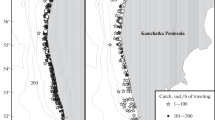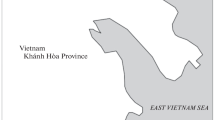Abstract
We studied spatial distribution, social behaviour and temporal patterns of daily activity of two different size classes of masked greenling, Hexagrammos octogrammus, during the non-breeding period (June to early September 1986-1988) in the Sea of Japan because of appreciable differences in young and adult fish social behaviour and habitat preferences. Small, young fish (1 year old, SL 50–130 mm) inhabited the rocky littoral zone where aquatic predators were absent and food sources were limited. Small greenling were territorial and occupied and guarded areas ranging from 1.5 to 2.5 m2. Adult fish (> 2 years old, SL 140–240 mm) occupied the upper sublittoral zone, with high food abundance. They were non-territorial and were moving within home ranges up to several hundreds of square meters. A few young greenling were observed in sublittoral ‘adult’ habitats. However, they displayed territorial behaviour. Similarly, several adults, present consistently in rocky sublittoral habitat were non-territorial. Aggressive bouts very rarely observed between adult fish. We suggest that young and adult greenling have different social behaviour resulting from the interval of ontogenetic development, and not related to food abundance.
Similar content being viewed by others
References cited
Baskin, L.M. 1976. The undulate animal behaviour. Nauka, Moscow. 293 pp. (in Russian)
Brown, J. L. 1964. The evolution of diversity in avian territorial systems. Wilson Bulletin 76: 160–169.
Brown, J.L. & G.H. Orians. 1970. Optimal foraging: the marginal value theorem. Theoretical and Population Biology 9: 129–136.
Charnov, E.L., G.H. Orians & K. Hyatt. 1976. Ecological implication of resource depression. Amer. Natur. 110: 247–259.
Chiszar, D. & R.W. Drake. 1975. Aggressive behaviour in rainbow trout Salmo gairdneri Richardson of two ages. Behav. Biology 133: 425–431.
Cole, K.S. & D.L. Noakes. 1980. Development of early social behaviour of rainbow trout, Salmo gairdneri. Behav. Process. 6: 97–112.
Davis, R.E. & J. Kessel. 1975. The ontogeny of the antagonistic behaviour and the onset of sexual maturation in the paradise fish, Macropodus opercularis Linneus. Behav. Biology 14: 31–39.
DeMartini, E.E. & M.E. Anderson 1980. Comparative survivorship and life history of painted greenling (Oxylebius pictus) in Puget Sound, Washington and Monterey Bay, California. Env. Biol. Fish. 5: 33–47.
DeMartini, E.E. 1985. Social behaviour and coloration changes in painted greenling, Oxilebius pictus Pisces, Hexagrammidae. Copeia 1985: 966–975.
Dill, P. A. 1977. Development of the behaviour in alevins of Atlantic salmon, Salmo salar, and rainbow trout, S. gairdneri. Anim. Behav. 25: 116–121.
Gomelyuk, V.E., A.G. Gamburtseva & V.B. Sacharov. 1989. Patterns of variation of corneal light filters in the masked greenling Hexagrammos octogrammus over 24-hours period in its natural habitats. Russian Journal of Ichthyology 29: 79–84 (in Russian).
Gorbunova, N.N. 1970. Spawning and embryonic development of greenlings family hexagrammidae. pp. 121–185. In: T.S. Rass (ed.) Greenlings: Taxonomy, Biology Interoceanic Transplantation, Academy of Science of the USSR. (Trans. Inst. Oceanol, Israel Program for Scientific Translation, Jerusalem).
Grant, J.W. & D.L.G. Noakes. 1987. Movers and stayers: foraging tactics of young-of the-year brook charr, Salvelinus fontinalis (Pisces, Salmonidae), Behav. Ecology and Sociobiology 22: 435–445.
Guthrie, D.M. & W.R.A. Muntz. 1992. Role of vision in fish behaviour. pp. 89–128. In: T.J. Pitcher (ed.) Behaviour of Teleost Fishes, Chapman and Hall, London.
Hinde, R.A. 1970. Animal behaviour. McGraw-Hill, New York. 876 pp.
Hurshbarger, T.J. 1979. Scraping improves silver nitrate brands on trout. Progr. Fish-Cult. 41:2: 209–211.
Huntingford, F.A. 1992. Development of behaviour in fish. pp. 57–80. In: T.J. Pitcher (ed.) Behaviour of Teleost Fishes, Chapman and Hall, London.
Huntingford, F.A. & A. Turner. 1987. Animal conflict. Chapman and Hall, London. 488 pp.
Jones, G.P. 1983. Relationship between density and behaviour in juvenile Pseudilabrus celidotus (Pisces: Labridae). Animal Behaviour 31: 729–735.
Kafanov, A.I., V.E. Zhukov & P.A. Fedotov. 1984. Composition and spatial distribution in summer fauna of Amphipodae in littoral zone of Vytijaz Bay. pp. 28–31. In: O.G. Kusakin (ed.) Hydrobiological Investigations in Bays and Gulfs in Primorsky Region of the USSR, Academy of Science Publishing, Vladivostok (in Russian).
Kawanabe, H. 1969. The significance of social structure in production of the \lsayu\rs, Plecoglossus altivelis. pp. 243–251. In: T.G. Northcote (ed.) Symposium on Salmon and Trout in Streams, Institute of Fisheries, The University of British Columbia, Vancouver.
Keenleyside, M.H.A. & T. Yamamoto. 1962. Territorial behaviour of juvenile Atlantic salmon Salmo salar. Behaviour 119: 139–169.
Keenleyside, M.H.A. 1979. Diversity and adaptation in fish behaviour. Springer-Verlag, Berlin. 208 pp.
Kurita, Y, M. Sano & M. Shimizu. 1991. Age and growth of the hexagrammid fish Hexagrammos agrammus at Aburatsubo, Japan. Bull. Japan. Soc. Sci. Fish. 577: 1293–1299.
Ludwig, J.A. & J.F. Reynolds. 1988. Statistical ecology: a primer on methods and computing. A. Wiley-Interscience Publication. New York, 337 pp.
Lysenko, V.N. 1985. Growth, spawning and production of five species of shrimps in sea-grasses communities in Melkovodnaya Bay, Sea of Japan. Russian Journal of Marine Biology 1: 28–31.
Magnuson, J.J. 1962. An analysis of aggressive behaviour, growth, and competition for food and space in medaka Orysias latipes (Pisces, Cypridontidae), Can. J. Zool. 40: 313–363.
Monaghan, P. & N.B. Metkalf. 1985 Group foraging in wild brown hares: effects of resource distribution and social status. Anim. Behav. 33: 993–999.
Noakes, D.L.G. 1978. Ontogeny of behaviour in fishes: a survey and suggestions. pp. 103–125. In: G.M. Burghardt & M. Bekoff (ed.) The Development of Behaviour, Garland Press, New York.
Odum, E.P. 1975. Ecology: the link between the natural and the social sciences. Holt, Rinehart & Winston, New York. 244 pp.
Pemberton, S.G. & R.W. Frey. 1984. Quantitative method in ichnology[sic]: spatial distribution among populations. Lethaia 17: 39–49.
Radakov, D.V. & L.M. Baskin. 1974. Some theoretical aspects in investigation in group life of vertebrate fishes and mammals. pp. 32–41. In: B.P. Manteufel (ed.) Ecological and Evolutional Aspects in Animal Behaviour, Nauka, Moscow (in Russian).
Rutenberg, E. P. 1970. Survey of the fishes of the family Hexagrammidae. pp. 1–103. In: T.S. Rass (ed.) Greenlings: Taxonomy, Biology Interoceanic Transplantation, Academy of Science of the USSR (Trans. Inst. Oceanol. Israel Program for Scientific Translation, Jerusalem).
Sale, P.F. 1975. Patterns of use of space in a guild of territorial reef fishes. Mar. Biol. 29: 89–97.
Thorpe, J.E. 1989. Development of variation in salmonid populations. J. Fish Biol. 35: 295–303.
Tinbergen, N. 1963. On aims and methods of ethology. Zeitchrift f\:ur Tierpsychol. 20: 410–429.
Volova, G.N., T.I. Zhakina & L.V. Mikulich. 1980. Benthos of Alekseeva Cove Peter the Great Bay, Sea of Japan. pp. 32–56. In: V.A. Kudryashev (ed.) Inshore Plankton and Benthos of North Part of Sea of Japan, Academy of Science Publishing, Vladivostok (in Russian).
Wallace, J.C., A.G. Kolberinshavn & T.G. Reinsnes. 1988. The effects of stocking density on early growth in Arctic charr, Salvelinus alpinus L. Aquaculture 73: 101–110.
Warner, R.R. & S.G. Hoffman 1980. Population density and the economics of territorial defence in a coral reef fish. Ecology 61: 772–780.
Watson, A.J. & R. Moss. 1970. Dominance, spacing behaviour and aggression in relation to population limitation in vertebrate. pp. 167–222. In: A. Watson (ed.) Animal Population in Relation to Their Resources, Oxford University Press, Edinburgh.
Wiens, J.A. 1976. Population responses to patchy environments. Ann. Rev. Ecol. System. 7: 81–120.
Wilson, E.O. 1975. Sociobiology: the new synthesis. Belknap Press, Cambridge. 697 pp.
Wootton, R.J. 1992. Fish ecology. Chapman and Hall, London. 212 pp.
Wyman, R.L. & L. Hotaling. 1988. A test of the model of the economic defendability of a resource and territoriality using young Etroplus maculatus and Pelmatochromis subocellatus kribensis. Env. Biol. Fish. 21: 69–76.
Wynne-Edwards, V.C. 1962. Animal dispersion in relation to social behaviour. Oliver and Boyd, Edinburgh. 656 pp.
Author information
Authors and Affiliations
Rights and permissions
About this article
Cite this article
Gomelyuk, V.E., Leunov, V.P. Changes in age-specific behaviour and spatial structure of masked greenling, Hexagrammos octogrammus Hexagrammidae). Environmental Biology of Fishes 54, 313–323 (1999). https://doi.org/10.1023/A:1007568903520
Issue Date:
DOI: https://doi.org/10.1023/A:1007568903520




